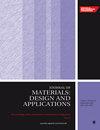基于 ABS-M30i 的 3D 打印生物启发牛骨结构的高应变率响应
IF 2.2
4区 材料科学
Q3 MATERIALS SCIENCE, MULTIDISCIPLINARY
Proceedings of the Institution of Mechanical Engineers, Part L: Journal of Materials: Design and Applications
Pub Date : 2024-04-04
DOI:10.1177/14644207241244731
引用次数: 0
摘要
为了研究衰老引起的骨质疏松症和雄性牛小梁骨的动态行为,选择了三个年龄组的雄性牛小梁骨,并进行了显微计算机断层扫描(CT)分析,以建立基于图像的生物启发计算机辅助设计(CAD)骨结构模型。通过进一步的实验和计算研究,考察了该结构随年龄变化的速率依赖行为和压缩能量吸收能力。为了评估这项研究,使用 ABS-M30i 材料 3D 打印了基于微型 CT 的结构 CAD 模型,并对其进行了准静态压缩(低应变率)和高应变率(分裂霍普金森压力棒)压缩。研究结果表明,当应变速率大于 430 s-1 时,三维打印的牛体结构具有明显的高应变速率依赖性,并且在峰值应力、高原应力和能量吸收能力方面对应变速率具有敏感性。利用速率依赖性特性,计算分析中使用了约翰逊-库克损伤塑性模型来解释骨质疏松症导致的骨骼动态行为。总体而言,数值模拟与实验数据之间具有良好的一致性,这是在实验结果的基础上对模型进行验证和确认后得到的。本文章由计算机程序翻译,如有差异,请以英文原文为准。
High strain rate response of ABS-M30i-based 3D printed, bio-inspired, bovine bone structure
To investigate osteoporosis caused by aging and the dynamic behavior of male bovine trabecular bone, three age groups of male bovine trabecular bone were chosen, and micro-computed tomography (CT) analysis was performed to develop an image-based bio-inspired computer-aided design (CAD) model of the bone structure. Further experimental and computational studies were carried out to examine the rate-dependent behavior and compressive energy-absorbing capacity of the structure as a function of age. To evaluate this study, a micro-CT-based CAD model of the structure was 3D printed using ABS-M30i material and subjected to quasi-static compression (low strain rate) and high strain rate (split Hopkinson pressure bar) compression. The findings show that 3D-printed bovine structures have distinct high-rate dependence at strain rates greater than 430 s−1 , as well as sensitivity to strain rate in terms of peak stress, plateau stress, and energy absorption capacity. Using rate-dependent properties, the Johnson–Cook damage plasticity model was used in computational analysis to explain the dynamic behavior of bone due to osteoporosis. Overall, there is good agreement between the numerical simulations and the experimental data, which was obtained by verifying and validating the model against the experimental results.
求助全文
通过发布文献求助,成功后即可免费获取论文全文。
去求助
来源期刊

CiteScore
4.70
自引率
8.30%
发文量
166
审稿时长
3 months
期刊介绍:
The Journal of Materials: Design and Applications covers the usage and design of materials for application in an engineering context. The materials covered include metals, ceramics, and composites, as well as engineering polymers.
"The Journal of Materials Design and Applications is dedicated to publishing papers of the highest quality, in a timely fashion, covering a variety of important areas in materials technology. The Journal''s publishers have a wealth of publishing expertise and ensure that authors are given exemplary service. Every attention is given to publishing the papers as quickly as possible. The Journal has an excellent international reputation, with a corresponding international Editorial Board from a large number of different materials areas and disciplines advising the Editor." Professor Bill Banks - University of Strathclyde, UK
This journal is a member of the Committee on Publication Ethics (COPE).
 求助内容:
求助内容: 应助结果提醒方式:
应助结果提醒方式:


